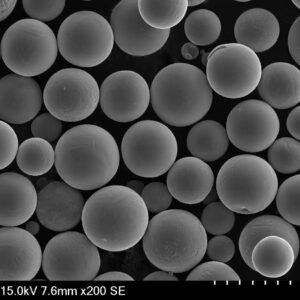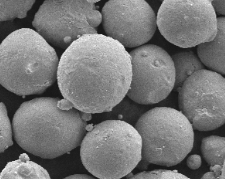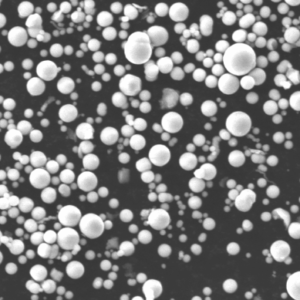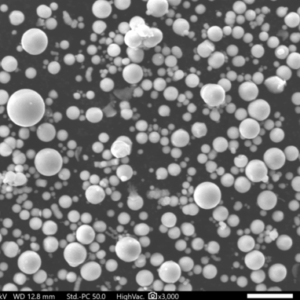粒度分布 (PSD)は、医薬品から冶金に至るまで様々な分野における基本的な概念であり、材料の挙動を理解し、製造プロセスを最適化し、製品の品質を確保するために極めて重要です。金属粉末、ポリマー、医薬品成分のいずれを扱う場合でも、PSDの複雑さを把握することは、プロジェクトの成功に大きく影響します。この包括的なガイドでは、金属粉末における粒度分布の重要性、その測定方法、およびお客様のアプリケーションにとっての意味を中心に、粒度分布の重要な側面を掘り下げています。
粒度分布の概要
粒度分布とは、与えられたサンプル内の粒子サイズの範囲と頻度を指します。一握りの砂を想像してみてください。これらの粒径のばらつきと、各粒径が混合物中に出現する頻度が粒度分布を形成します。流動性、充填密度、表面積、反応性などの材料特性に影響するため、工業環境ではPSDは非常に重要です。
粒度分布が重要な理由
PSDは様々な材料の特性や挙動に影響を与えるため、PSDを理解することは極めて重要である:
- 流動性: より細かい粒子は互いにくっつき、材料の流れに影響を与える可能性がある。
- 反応性: 粒子が小さいと表面積が大きくなり、反応性が高くなる。
- 梱包密度: 粒子径の組み合わせは、材料がどれだけ密に詰められるかを決定し、その強度や安定性に影響を与える。
- 製品の一貫性: 例えば医薬品では、PSDは薬剤の体内吸収に影響を与える。
金属粉末の粒度分布を理解する
金属粉とは何か?
金属粉末は、積層造形、粉末冶金、コーティング用途など、さまざまな製造工程で使用される金属や合金の微粒子です。これらの粒子のサイズと分布は、最終製品の品質、強度、性能に大きく影響します。

金属粉末におけるPSDの重要性
金属粉末の粒度分布は、製造時の流動性、充填密度、焼結挙動を決定する上で非常に重要である。例えば
- 流動性: 3Dプリンティングのように、ノズルのスムーズな流れが要求される工程に最適。
- 梱包密度: 最終製品の密度と強度に影響する。
- 焼結: 小さな粒子は通常、より低い温度で焼結するため、プロセスのエネルギー効率に影響を与える。
金属粉末の種類とPSD特性
以下は、一般的な金属粉末とその組成、典型的なPSD特性をまとめた表である。
| 金属粉 | 構成 | 典型的なPSD | 主な特徴 | 一般的なアプリケーション |
|---|---|---|---|---|
| アルミニウム(Al) | 純アルミニウム | 10-100 µm | 軽量、良好な熱伝導性 | 航空宇宙、自動車 |
| ステンレス鋼 | 鉄、クロム、ニッケル | 15-150 µm | 耐食性、耐久性 | 医療機器、キッチン用品 |
| チタン(Ti) | 純チタン | 20-200 µm | 高い強度対重量比、生体適合性 | 航空宇宙、医療用インプラント |
| 銅(Cu) | 純銅 | 10-100 µm | 優れた導電性 | エレクトロニクス、電気配線 |
| ニッケル(Ni) | 純ニッケル | 15-150 µm | 高耐食性、磁気特性 | バッテリー、電子機器 |
| ブロンズ | 銅、錫 | 20-200 µm | 高い耐摩耗性、低摩擦 | ベアリング、ブッシュ |
| コバルト・クロム | コバルト、クロム | 15-100 µm | 高強度、耐食性 | 歯科インプラント、航空宇宙部品 |
| 鉄(Fe) | 純鉄 | 10-120 µm | 磁気特性、高強度 | 自動車、建設 |
| インコネル | ニッケル、クロム | 15-150 µm | 耐高温性、耐酸化性 | 航空宇宙、化学処理装置 |
| マグネシウム (Mg) | 純粋マグネシウム | 20-150 µm | 軽量、良好な加工性 | 自動車、エレクトロニクス、航空宇宙 |
金属粉末のPSDに影響を与える要因
- 生産方法: 霧化、粉砕、電解はすべて、異なるPSDを持つ粉末を生成する。
- 素材構成 合金が異なれば、材料特性が異なるため、粒度分布に影響を与える可能性がある。
- 加工条件: 粉体製造時の温度、圧力、その他の要因はPSDに影響を与える可能性がある。
測定技術 粒度分布
PSDの正確な測定は、様々な産業における品質管理に不可欠である。いくつかの技術が使用され、それぞれに利点と限界があります。
一般的な測定技術
| テクニック | 原則 | 代表的な粒子径範囲 | メリット | 制限事項 |
|---|---|---|---|---|
| レーザー回折 | 粒子によるレーザー光の散乱 | 0.01-3000 µm | 高速、広範囲、非破壊 | 球状の粒子を想定、高価 |
| ふるい分け | メッシュサイズによる機械的分離 | 45-10000 µm | シンプルで安価 | 大きな粒子に限られ、時間がかかる |
| 動的光散乱(DLS) | 散乱光のゆらぎ | 1 nm-6 µm | ナノ粒子に適した高感度 | 粒径が小さく、複雑なものに限る |
| 堆積 | 流体中の沈降速度 | 0.5-300 µm | 微粒子に最適 | 遅い、粒子形状に影響される |
| 顕微鏡検査 | 顕微鏡による直接観察 | 0.1-1000 µm | 目視検査、形状分析 | 時間がかかる、主観的 |
| コールターカウンター | 粒子がオリフィスを通過する際の電気インピーダンスの変化 | 0.1-1200 µm | 正確、ワイドレンジ | 高価、導電性液体が必要 |
正しいテクニックの選択
測定技術の選択はいくつかの要因に左右される:
- 粒子径範囲: 粒子が大きい場合と小さい場合に適した方法がある。
- 素材: 材料の光学的特性や導電性によって方法が決まるかもしれない。
- 正確さ: アプリケーションによってはより高い精度が要求され、より高度な技術の使用が正当化される場合がある。
- コストだ: 予算上の制約から、より手頃な方法を選択することになるかもしれない。
金属粉末の粒度分布の組成
金属粉末の粒度分布の組成は、様々な用途におけるその性能に影響する重要な側面である。このセクションでは、平均粒子径、分布幅、微粒子または粗粒子の存在などの要素を含むPSD組成の詳細について掘り下げます。
PSD構成における主要パラメーター
| パラメータ | 説明 |
|---|---|
| 平均粒子径 | 試料に含まれる粒子の平均粒子径で、マイクロメートル(µm)単位で測定されることが多い。 |
| 分布幅 | 試料内の粒子径の範囲。均一性またはばらつきを示す。 |
| 微粒子 | 流動性と反応性に影響を及ぼす可能性のある、PSDの下限にある粒子。 |
| 粗い粒子 | 充填密度と強度に影響を及ぼす可能性のある大きな粒子。 |
| 歪度 | 分布曲線の非対称性は、粒子が細かい方または粗い方に偏っていることを示す。 |
特定金属粉末におけるPSD
それぞれの金属粉末はユニークなPSDを示し、その特性や異なる用途への適合性に影響を与えます。以下にいくつかの例を示す:
- アルミパウダー: 通常、平均粒子径が約20~30μmと狭いPSDを持ち、航空宇宙分野の軽量部品に最適である。
- ステンレススチール・パウダー: 多くの場合、PSDは10µmから100µmと広く、強度と耐食性のバランスがとれている。
- チタンパウダー: PSDの平均サイズは15µmから150µmと幅が広く、高い強度対重量比を必要とする用途に合わせて調整されている。
PSDに基づく金属粉末の用途
粒度分布は、様々な用途に対する金属粉末の適合性を決定する上で重要な役割を果たします。以下は、一般的な用途と、それぞれに好ましいPSD特性をまとめた表です。
| 申し込み | 好ましい金属粉末 | 理想的なPSDの範囲 | PSDが重要な理由 |
|---|---|---|---|
| 3Dプリンティング | アルミニウム、チタン | 10-60 µm | スムーズな流れと正確なレイヤリング |
| 粉末冶金 | ステンレススチール、鉄 | 20-100 µm | 焼結挙動と最終強度に影響 |
| 溶射 | ニッケル、銅 | 20-80 µm | コーティングの厚みと均一性をコントロール |
| アディティブ・マニュファクチャリング | コバルトクロム、インコネル | 15-50 µm | 高解像度部品に不可欠 |
| エレクトロニクス | 銅、銀 | 10-40 µm | 導電性と回路の完全性に影響 |
| 自動車部品 | マグネシウム、鉄 | 20-150 µm | 部品の密度と機械的特性に影響 |
| 航空宇宙部品 | チタン、アルミニウム | 10-80 µm | 強度と軽量化のバランス |
| 医療用インプラント | チタン、コバルトクロム | 15-70 µm | 生体適合性と耐久性を確保 |
| 電池材料 | ニッケル、リチウム | 5-30 µm | エネルギー密度と充電率に影響 |
| 触媒 | プラチナ、パラジウム | 1-20 µm | 化学反応のための表面積を最大化する |
特定用途におけるPSDの影響
それぞれの用途において、金属粉末のPSDは最終製品の性能に大きな影響を与える。例えば
- 3Dプリンティング: 狭いPSDは、粉末がプリンターノズルをスムーズに流れることを保証し、正確な積層を可能にし、欠陥を最小限に抑える。
- 粉末冶金: 十分に制御されたPSDは均一な焼結をもたらし、その結果、一貫した密度と強度を持つ部品が得られる。
- 溶射: PSDは塗膜の厚みと均一性に影響し、過酷な環境下での保護塗膜にとって極めて重要である。
最適化の利点 粒度分布
金属粉末の粒度分布を最適化することは、様々な産業において多くの利点をもたらします。このセクションでは、十分に制御されたPSDを持つことの主な利点を紹介します。
材料特性の向上
- 流動性の向上: 均一なPSDは、供給システムでの目詰まりの可能性を減らし、スムーズな処理を保証する。
- 梱包密度の向上: バランスの取れたPSDは、よりタイトなパッキングを可能にし、より高密度で強固な部品へと導く。
- より良い表面積コントロール: PSDを微調整することで、表面積を最適化することができ、触媒や電池材料などの用途に極めて重要である。
プロセスの効率化とコスト削減
- 焼結温度の低下: 粒子が小さいほど低い温度で焼結できるため、エネルギー消費とコストを削減できる。
- 廃棄物の削減: 一貫したPSDは、再処理や規格外の材料を廃棄する必要性を最小限に抑え、コスト削減につながる。
- 収量の向上: 最適化されたPSDは、欠陥の少ない高品質な製品につながり、全体的な歩留まりを向上させる。
製品性能の向上
- より高い強度重量比: 軽量化が重要な航空宇宙用途や自動車用途では特に重要である。
- 耐食性の向上: ある種のPSDは、コーティングの保護性を高め、部品の寿命を延ばすことができる。
- より優れた熱伝導性: 電子機器では、最適化されたPSDは部品の熱管理を改善し、過熱を防ぐことができる。
最適化PSDと非最適化PSDの比較
| アスペクト | 最適化されたPSD | 最適化されていないPSD |
|---|---|---|
| 流動性 | スムーズで安定したフロー | 目詰まりの可能性、不規則な流れ |
| 梱包密度 | 高く、強力な部品につながる | 部品が弱くなる |
| 表面積コントロール | 正確に管理され、反応性を高める | コントロールが悪く、一貫性のないパフォーマンス |
| 焼結温度 | より低く、エネルギーを節約 | エネルギーコストの上昇 |
| 廃棄物削減 | 最小限の廃棄物、費用対効果 | 廃棄物の増加、コストの上昇 |
| 製品の品質 | 高品質で欠陥のない製品 | 不良率が高く、全体的な品質が低い |
粒度分布制御の課題
PSDの最適化には多くのメリットがある一方で、望ましい結果を得るために対処しなければならない課題もいくつかある。
PSD管理における課題
| チャレンジ | 説明 | インパクト | 緩和戦略 |
|---|---|---|---|
| 一貫性のない生産 | 生産工程のばらつき | 一貫性のないPSDにつながる | 厳格な品質管理対策の実施 |
| 測定精度 | PSDを正確に測定することの難しさ | 信頼性の低いデータ | 高度な測定技術を使う |
| 最適化のコスト | 均一なPSDを実現するための高いコスト | 生産コスト全体の増加 | コストと性能要件のバランス |
| 材料感度 | PSDの変更に敏感な素材がある | 材料特性と性能に影響 | 徹底的なテストと検証の実施 |
| 環境要因 | 湿度、温度、汚染 | 製造・保管中にPSDを変更する可能性がある | 環境条件を綿密に管理する |
PSD最適化における課題の克服
PSDの最適化を成功させるには、高度な技術、厳格な品質管理、そして材料の挙動に関する深い理解の組み合わせが必要です。いくつかの戦略には以下が含まれる:
- 高度な測定ツール: 正確なPSDデータを得るために、レーザー回折や動的光散乱のようなツールを使用する。
- 厳格な工程管理: PSDのばらつきを最小限に抑えるため、生産時に厳格な管理を実施する。
- 継続的なモニタリング: 環境要因がPSDに悪影響を与えないよう定期的に監視する。
適切な金属粉末サプライヤーの選択
適切なサプライヤーを選択することは、金属粉末の品質と一貫性を確保する上で非常に重要です。
サプライヤーを選択する際の主な考慮事項
| 考察 | なぜ重要なのか | 何を見るべきか |
|---|---|---|
| 品質管理 | 一貫したPSDと素材の品質を保証 | ISO認証、厳格な試験プロトコル |
| テクニカルサポート | PSDの最適化を支援 | 専門家へのアクセス、カスタムPSD分析 |
| サプライチェーンの信頼性 | タイムリーな納入と可用性を保証 | 強力な物流ネットワーク、在庫管理 |
| コストと価格 | プロジェクト全体の予算に影響 | 競争力のある価格設定、透明性の高いコスト構造 |
| 評判とレビュー | サプライヤーの信頼性と顧客満足度を示す | 好意的な評価、長年の評判 |
金属粉末のサプライヤーを比較する
| サプライヤー | 所在地 | 主要製品 | 価格(Kgあたり) | 品質認証 | カスタマーレビュー |
|---|---|---|---|---|---|
| ABCメタルズ | アメリカ | アルミニウム、ステンレス鋼 | $50-$200 | ISO9001、ASTM認証 | 4.5/5 |
| グローバルパウダー株式会社 | ドイツ | チタン、コバルトクロム | $80-$250 | ISO13485、REACH対応 | 4.7/5 |
| パウダーテック | 中国 | 銅、ニッケル、ブロンズ | $30-$150 | ISO 9001、RoHS対応 | 4.3/5 |
| 株式会社メタルパウダーズ | 英国 | インコネル、マグネシウム | $100-$300 | ISO9001、AS9100認証 | 4.6/5 |
| プライム・メタルズ | 日本 | ステンレス鋼、インコネル | $90-$280 | ISO14001、JIS規格 | 4.8/5 |
コストと品質のバランス
サプライヤーを選ぶ際には、コストと品質のバランスを取ることが不可欠です。低価格は魅力的に見えるかもしれませんが、一貫したPSDや素材の品質を犠牲にすることもあります。次のことを考えてみてください:
- 長期的な価値: より高品質のパウダーは、欠陥を減らし、歩留まりを向上させ、より長期的な価値を提供する。
- サプライヤーとの関係 信頼できるサプライヤーと強い関係を築くことは、より良い条件、カスタムPSDオプション、優先的なサービスにつながります。
比較分析:金属粉末における最適化PSDと標準PSDの比較
最適化されたPSDと標準的なPSDの違いを理解することで、材料の選択や加工技術について十分な情報を得た上で決断することができます。
最適化されたPSD
- メリット
- 材料特性(強度、反応性など)の向上。
- プロセス効率と歩留まりの向上
- 最終製品の品質管理の向上
- デメリット
- 生産コストの上昇。
- 高度な測定および制御技術を必要とする。
標準PSD
- メリット
- 生産コストの削減。
- よりシンプルな測定と制御プロセス。
- デメリット
- 材料の性能が低下する可能性がある。
- 欠陥や不整合のリスクが高い。
主要アプリケーションにおける最適化PSDと標準PSDの比較
| 申し込み | 最適化されたPSD | 標準PSD | 最終製品への影響 |
|---|---|---|---|
| 3Dプリンティング | スムーズなレイヤリング、正確なディテール | 目詰まりの可能性、不均一な層 | 最適化されたPSDは高解像度につながる |
| 粉末冶金 | 安定した焼結、高密度 | 密度がばらつき、焼結が安定しない | 標準的なPSDでは部品が弱くなる可能性がある |
| 溶射 | 均一な膜厚 | 不均一なコーティング、潜在的な欠陥 | 最適化されたPSDにより、より優れた表面保護を実現 |
| エレクトロニクス | 導電性、信頼性の向上 | 一貫性のない導電性、潜在的な故障 | 最適化されたPSDが回路性能を向上 |
| 航空宇宙部品 | 高い強度対重量比 | 強度低下、欠陥の可能性 | 最適化されたPSDは安全性とパフォーマンスにとって極めて重要 |
ケーススタディPSD最適化の実際の応用例
ケーススタディ1:航空宇宙産業
チャレンジだ: ある航空宇宙メーカーは、インコネル粉末で作られたタービンブレードの強度が一定しないという問題に直面していました。製造に使用される標準的なPSDは、焼結挙動にばらつきがあり、その結果、ブレードに弱点が生じました。
解決策 このメーカーは、平均粒径を中心に分布がタイトな最適化PSDに切り替えました。この変更は、より均一な焼結をもたらし、その結果、一貫性のあるタービンブレードを実現しました。
強さとパフォーマンスの向上。
成果だ: 最適化されたPSDに切り替えたことで、欠陥率は30%減少し、タービンブレードの寿命は20%延びた。
ケーススタディ2:医療用インプラント
チャレンジだ: チタン製インプラントを製造する医療機器メーカーが、インプラントの生体適合性に影響を及ぼす表面の不一致に苦慮していた。この問題は、チタン粉末の幅広いPSDに起因しており、表面が粗くなっていました。
解決策 同社は、より滑らかな表面を実現するため、微粒子に焦点を当て、より制御されたPSDを導入した。
成果だ: 最適化されたPSDは、インプラントの表面をより滑らかにし、生体適合性を高め、拒絶反応率を15%減少させた。同社はまた、患者の転帰が改善され、同社のインプラントに対する需要が増加したことにも言及している。
ケーススタディ3:積層造形
チャレンジだ: 自動車部品に3Dプリンティングを使用しているメーカーが、アルミニウム粉末の幅広いPSDに起因する、粉末の不均一な流れによって部品に欠陥が生じやすいことを発見した。
解決策 PSDを狭くすることで、粉末の流動性が向上し、3Dプリント工程でより正確な積層が可能になった。
成果だ: PSDが改善された結果、不良品が減少し、部品品質が向上したため、メーカーは後処理時間を25%短縮し、生産効率を高めることができた。

よくあるご質問
1.粒度分布(PSD)とは?
| 質問 | 回答 |
|---|---|
| PSDとは? | PSDとは、与えられたサンプル内の粒子径のばらつきを指す。 |
| なぜPSDが重要なのか? | PSDは、流動性、反応性、密度などの材料特性に影響を与える。 |
| PSDの測定方法は? | 技術としては、レーザー回折、ふるい分け、DLS、顕微鏡などがある。 |
2.PSDは金属粉末にどのような影響を与えるか?
| 質問 | 回答 |
|---|---|
| PSDは金属粉末の流動性にどのような影響を与えますか? | PSDがうまく制御されることで、スムーズな流れが確保され、処理の問題が軽減される。 |
| 焼結におけるPSDの役割とは? | PSDは焼結プロセスの温度と均一性に影響する。 |
| PSDは金属部品の強度に影響しますか? | そう、一貫したPSDは、より強く、より信頼できる部品につながる。 |
3.アプリケーションに適したPSDを選ぶには?
| 質問 | 回答 |
|---|---|
| PSDを選択する際に考慮すべき点は何ですか? | 用途要件、材料特性、加工方法を考慮してください。 |
| 特定のアプリケーション用にPSDをカスタマイズできますか? | はい、多くのサプライヤーがお客様のニーズに合わせたカスタムPSDオプションを提供しています。 |
| 最適化されたPSDの利点とは? | その利点には、材料性能、工程効率、製品品質の向上が含まれる。 |
4.PSD最適化の課題とは?
| 質問 | 回答 |
|---|---|
| PSDのコントロールにはどのような課題があるのか? | 測定精度、製造のばらつき、コストなどの課題がある。 |
| どうすればこれらの課題を克服できるのか? | 高度な測定ツールを使用し、厳格な品質管理を実施し、環境要因を監視する。 |
5.PSDを制御した金属粉末の主要サプライヤーは?
| 質問 | 回答 |
|---|---|
| 金属粉末の信頼できるサプライヤーは? | ABC Metals、Global Powder Co、PowderTechといったサプライヤーが評判が良い。 |
| サプライヤーに何を求めるべきか? | 品質管理認証、テクニカル・サポート、競争力のある価格設定に注目してください。 |
結論
理解と最適化 粒度分布 は、航空宇宙から医療機器に至るまで、様々な産業において極めて重要です。適切なPSDは、材料特性を大幅に向上させ、工程効率を改善し、製品品質を高めることができます。PSDの最適化には課題がありますが、適切な戦略、ツール、サプライヤーとのパートナーシップによって克服することができます。アプリケーションの具体的なニーズに焦点を当て、適切なPSDを選択することで、より良い結果、より低いコスト、より大きなプロジェクトの成功を達成することができます。














